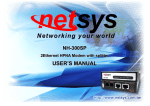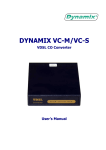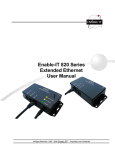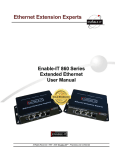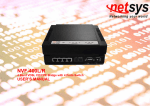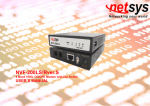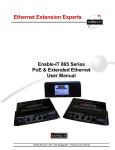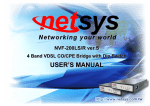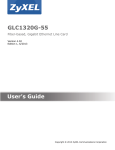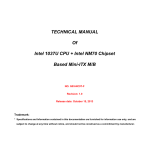Download CTC Union VDTU01 Product specifications
Transcript
VDSL. CTC Union Content Contents 1. Unpacking Information Check List ---------------------------------------------------- 1 2. Installation Hardware Installation -------------------------------------- 2 Pre-Installation Requirements --------------------------- 2 General Rules ----------------------------------------------- 3 Connecting the Converter -------------------------------- 3 Connecting the RJ-11/RJ-45 Ports-------------------------- 4 2. Hardware Description Front Indicators---------------------------------------------- 7 Rear Connectors-------------------------------------------- 9 Power On ----------------------------------------------------- 9 4. Applications Application for Home networking ----------------------- 10 Appendix A Cable Requirement ---------------------------------- 12 Appendix B Product Specifications----------------------------- 14 Appendix C Trouble Shooting ------------------------------------ 15 Appendix D Link Watch Dog (LWG)----------------------------- 20 Appendix E Compliant and Safety Information ------------- 21 i VDSL. CTC Union 1. Unpacking Information Check List Carefully unpack the package and check its contents against the checklist Package Contents Ethernet to VDSL Converter Four plastic feet Diskette User Manual AC to DC 100V-240V Switching Power Adapter Ethernet Straight-through cable RJ-11 cable Please inform your dealer immediately for any missing, or damaged parts. If possible, retain the carton, including the original packing materials; use them to repack the unit in case there is a need to return for repair. 1 VDSL. CTC Union 2. Installing the Converter Hardware Installation This chapter describes how to install the converter and establishes network connections. You may install the converter on any level surface (e.g., a table or shelf). However, please take note of the following minimum site requirements before you begin. Stick the 4 plastic feet at the bottom. Pre-installation Requirements Before you start actual hardware installation, make sure you can provide the right operating environment, including power requirements, sufficient physical space, and proximity to other network devices that are to be connected. Verify the following installation requirement: Power requirements: AC100 to 240V at 50 to 60 Hz. The Switch power supply automatically adjusts to the input voltage level. The converter should be located in a cool dry place, with at least 10cm/4in of space at the front and back for ventilation. Place the Converter out of direct sunlight, and away from heat sources or areas with a high amount of electromagnetic interference. Check if network cables and connectors needed for installation are available 2 VDSL. CTC Union General Rules Before making connections to the converter, note the following rules: Ethernet Port (RJ-45) All network connections to the Converter Ethernet port must be made using Category 5 UTP for 100Mbps; Category 3,4 UTP for 10Mbps No more than 100 meters of cabling may be use between the MUX or HUB and an end node. VDSL Port (RJ-11) All Home network connections to the RJ-11Port made using 24~26 Gauge phone wiring. We do not recommend using 28 Gauge or above phone line. Connecting the Converter The converter has one ETHERNET port which support connection to Ethernet operation. The devices attached to these ports must support auto-negotiation or 10Base-T OR 100Base-TX unless they will always operate at half duplex. Use any of the Ethernet ports to connect to devices such as HUB, concentrator, bridge or router. You can also connect to another compatible converter to an RJ-45 port on the other device. The RJ11 Line port are use to connect to the wall RJ-11 modular socket which is connect to VDSL Switch or VDSL converter CO side The RJ11 Phone port of the converter can connected to a telephone and a computer sharing one telephone wire for making calls and accessing the Internet at the same time. 3 VDSL. CTC Union Connecting the RJ-11 Ports 1. The Converter’s RJ-11 ports support the transmission of data up to 10Mbps across existing phone wiring, without interfering with standard voice transmissions, easy-to-use does not require the installation of any additional wiring. Every RJ-11 modular phone jack in the home can become a port on the LAN. Networking devices can be installed on a single telephone wire that can span within 1.2kM (4000 feet) between the two farthest points. (Figure 1.0). 2. VDSL Converter has embedded Splitter between every VDSL side (Line) and POTS (Phone) side. It permit you can delivers broadband service on the same lines as Plain Old Telephone Service (POTS), PBX, ISDN traffic and VDSL Signal. Figure 1.0 converter use as adapter to connect RJ-11 and the LAN card inside the computer Ethernet wiring Phone wiring T To telephone or FAX or ISDN modem To VDSL Concentrator (VDSL Switch) 10/100 Fast Ethernet 4 Networking Interface Card VDSL. CTC Union 1. The RJ-11 port supports 10 Mbps connections. When inserting a RJ-11 plug, be sure the tab on the plug clicks into position to ensure that it is properly seated. 2. Do not plug a RJ-11 phone jack connector into the Ethernet port (RJ-45 port). This may damage the converter Instead; use only twisted-pair cables with RJ-45 connectors that conform to FCC standard. Notes: 1. Be sure each twisted-pair cable (RJ-45) does not exceeds 100 meters (333 feet). 2. RJ-11 port use 24 ~ 26 gauge phone wiring, we do not recommend 28 gauge or above. 3. We advise using Category 3,4,5 cable for Cable Modem or Router connections to avoid any confusion or Inconvenience in the future when you upgrade attached to high band width devices. 5 VDSL. CTC Union 6 VDSL. CTC Union 3. Hardware description This section describes the important parts of the converter. It features the front indicators and rear connectors. 3.1 Front Indicators The following figure shows the front panel. Figure Chapter 2.2 Front Indicators Three LED Indicators. At a quick glance of the front panel, it will be easy to tell if the converter has power, if it has signal from its Ethernet RJ-45 port and if there is phone line signal RJ-11port Front Indicators LED Description and Operation The Converter has three LED indicators. LEDs Status Descriptions It will light up (ON) to show that the product is power good, and system reset OK. Each RJ45 station port on the Ethernet is assigned an LED light for monitoring port Steady Green “Good Linkage”. LED is normally OFF Ethernet Flashing after the power on operation, but will light (Ethernet LED) (LINK/ACT) up steadily to show good linkage. And Flashing to show data transmission. RJ11 station port on the VDSL is assigned an LED light for monitoring port VDSL Steady Green “Good Linkage”. LED is normally OFF (VDSL LED) after the power on operation, but will light up steadily to show good linkage. Ready (Ready LED) Steady Green 7 VDSL. Rear Panel CTC Union The following figure shows the rear connectors Figure Chapter 2.3 Rear Connectors Converter Rear Connectors _____________________________________________________ Connectors Line Description Type For connecting to the RJ-11 wall jack RJ-11 Using a RJ-11 cable ______________________________________________________ Phone For connecting to the telephone or Fax RJ-11 or ISDN modem _____________________________________________________________ Ethernet For connecting to a Ethernet equipped device RJ-45 Note: The RJ 11 wired identically and therefore it’s interchangeable. Power On 1. Check the adapter is properly connected 2. Verify the power led is steady on 8 VDSL. CTC Union 3. Applications APPLICATION FOR HOME NETWORKING The 10Mbps Converter is used to connect any device equipped with a standard 10/100Mbps Ethernet port to a VDSL LAN. The Converter have been designed to operate on the telephone wire installed in homes throughout the world. They utilize the same modular patch cords and connectors commonly used for telephones. To install the Converter or to access the Internet, you simply plug into your existing telephone jacks just like you would a telephone modem or a fax machine. There is no need for special splitters, terminators or filters. In fact, there is no need to add or modify the home telephone wiring at all. The Converter uses a frequency division multiplexing approach that enables standard telephone wiring to simultaneously carry POTS voice, ISDN and VDSL signals without any of the services impacting each other. 9 VDSL. CTC Union Appendix A: Cable Requirements A CAT 3,4 or 5 UTP (unshielded twisted pair) cable is typically used to connect the Ethernet device to the converter. A 10Base-T cable often consists of four pairs of wires, two of which are used for transmission. The connector at the end of the 10Base-T cable is referred to as an RJ-45 connector and it consists of eight pins. The Ethernet standard uses pins 1,2,3 and 6 for data transmission purposes. Table RJ-45 Ethernet Connector Pin out Assignments PIN 1 2 3 4 5 6 7 8 MNEMONIC TX+ TXRX+ NC NC RXNC NC FUNCTION Ethernet differential Transmit signal (+) Ethernet differential Transmit signal (-) Ethernet differential receive signal (+) Unused Unused Ethernet differential receive signal(-) Unused Unused 10 VDSL. CTC Union Standard telephone wire of any gauge or type-flat, twisted or quad is used to connect the Converter to the telephone network. A telephone cable typically consists of three pairs of wires, one of which is used for transmission. The connector at the end of the telephone cable is called an RJ-11 connector and it consists of six pins. POTS (plain old telephone services) use pins 3 and 4 for voice transmission. shown below. Figure A telephone cable is Telephone cable A B The A and B connectors on the rear of the converter are RJ-11 connectors. These connectors are wired identically. The RJ-11 connectors have six positions, two of which are wiring, The Converter uses the center two pins. The pin out assignment for these connectors is presented below. Table Pin# 1 2 3 4 5 6 RJ-11 Pin MNEMONIC NC NC TIP RING out Assignments FUNCTION Unused Unused POTS POTS NC NC Unused Unused 11 VDSL. CTC Union Appendix B: Product Specification Product Name:VDSL To Ethernet Converter (VDSL Modem) Application:Home networking solution Product Specification: Compliant with IEEE 802.3 & 802.3u Ethernet Standards Compliant with ETSI, ITU, ANSI VDSL standards 10/100M auto-sensing RJ-45 Ethernet ports x 1 10Mbps VDSL RJ-11 port x 1 POTS / ISDN Splitter port RJ-11 x 1 Splitter on Board Surge Protection Switch Method:Store and Forward Full Duplex:IEEE 802.3x Half Duplex:Backpressure Driver capable:10M/1.2km Indication LED x 3 Ready LED x1 Ethernet Link/Active LED x 1 VDSL Link LED x 1 VDSL Frequency Spectrum: Transmitter :4.5 ~ 7.9MHz Receiver:0.9 ~ 3.0 MHz Power consumption:3.85 Watt Dimensions:95 x 110 x 24 mm, Weight:345 g Provides LED indication Link/Active for VDSL port. External switching power adapter Input:AC 85-240 volts/50-60Hz Output:DC 5V/2A Operating Temperature:5℃ ~ 50℃(41F ~ 122F) Storage Temperature:- 20℃ ~ 65℃(-4F ~ 149F) Humidity:10%~90% Non-Condensing 12 VDSL. CTC Union Appendix C: Troubleshooting Diagnosing the Converter’s Indicators The Converter can be easily monitored through its comprehensive panel indicators. These indicators assist the network manager in identifying problems the hub may encounter. This section describes common problems you may encounter and possible solutions 1. Symptom: Ready indicator does not light up (green) after power on. Cause: Defective External power supply Solution: Cheek the power plug by plugging in another that is functioning properly. Check the power cord with another device. If these measures fail to resolve the problem, have the unit power supply replaced by a qualified distributor. 2. Symptom: Link indicator does not light up (green) after making a connection. Cause: Network interface (e.g., a network adapter card on the attached device), network cable, or switch port is defective. Solution: 2.1 Power off them Power on the VDSL Modem. 2.2 Verify that the switch and attached device are powered on. 2.3 Be sure the cable is plugged into both the switch and corresponding device. 2.4 Verify that the proper cable type is used and its length does not exceed specified limits. 2.5 Check the converter on the attached device and cable connections for possible defects. 2.6 Replace the defective converter or cable if necessary. 2.7 Verify the VDSL switch and VDSL Modem during the same speed mode. You can select VDSL Speed mode by 10 Mbps. Only same speed mode can link and work. VDSL default translation mode is 10 Mbps. 13 VDSL. CTC Union 3. Symptom: I had a VDSL link. But, after disconnecting the line for several minutes, there is no link any more. Solution: This is normal behavior for the modem. A link watchdog Is activated in the VDSL modem, when ever is no link after a specified time. Users just re-plug the power of VDSL modem, and then they can link again and solve this problem. System Diagnostics Power and Cooling Problems If the POWER indicator does not turn on when the power cord is plugged in, you may have a problem with the power outlet, power cord, or internal power supply as explained in the previous section. However, if the unit power is off after running for a while, check for loose power connections, power losses or surges at the power outlet, and verify that the fan on back of the unit is unobstructed and running prior to shutdown. If you still cannot isolate the problem, then the internal power supply may be defective. In this case, contact your dealer. Installation Verify that all system components have been properly installed. If one or more components appear to be malfunctioning (e.g., the power cord or network cabling), test them in an alternate environment where you are sure that all the other components are functioning properly. Transmission Mode The default method of selecting the transmission mode for RJ-45 ports is 10/100 Mbps ETHERNET, for RJ-11 port are 10Mbps VDSL. Therefore, if the Link signal is disrupted (e.g., by unplugging the network cable and plugging it back in again, or by resetting the power), the port will try to reestablish communications with the attached device 14 VDSL. CTC Union via auto-negotiation. If auto-negotiation fails, then communications are set to half duplex by default. Based on this type of industry-standard connection policy, if you are using a full-duplex device that does not support auto-negotiation, communications can be easily lost (i.e., reset to the wrong mode) whenever the attached device is reset or experiences a power fluctuation. The best way to resolve this problem is to upgrade these devices to a version that support Ethernet and VDSL. Physical Configuration If problems occur after altering the network configuration, restore the original connections, and try to track the problem down by implementing the new changes, one step at a time. Ensure that cable distances and other physical aspects of the installation do not exceed recommendations System Integrity As a last resort verify the switch integrity with a power-on reset. Turn the power to the switch off and then on several times. If the problem still persists and you have completed all the preceding diagnoses, then contact your dealer 15 VDSL. CTC Union Appendix D: Link Watch Dog (LWD) Q: I had a VDSL link. But, after disconnecting the line for about eleven minute, there is no link any more. Is this normal? Yes, this is normal behavior for the modem. A Link Watchdog (LWD) is activated in the CPE whenever there is no link after a specified time (Eleven Seconds) Q: Why do I need an LWD? The LWD enables the VDSL Switch to reconnect to the CPE with known and predefined VDSL link values. This is necessary whenever loading of the normal VDSL link parameters fails, for example, because of a corrupted EEPROM. In such cases, the link remains down until both sides have the same VDSL link parameter values. In the VDSL Modem, LWD parameters are set automatically, after eleven minutes, whenever a VDSL link failure occurs. In the VDSL Switch, only management sets LWD parameters. CPE Side Start Link Watch Dog If CPE side (VDSL Modem) power on standby exceed 11 minute without connecting VDSL Switch, which will start up Link watch dog, you will find Link fail, users must re-plug power on once to clear that and reconnecting VDSL Switch. 16 VDSL. CTC Union Appendix E: Compliance and Safety Information FCC Radio Frequency Interference Statement This equipment has been tested and found to comply with the limits for a computing device, pursuant to Part 15 of FCC rules. These limits are designed to provide reasonable protection against harmful interference when the equipment is operated in a commercial environment. This equipment generates, uses and can radiate radio frequency energy and, if not installed and used in accordance with the instructions, may cause harmful interference to radio communications. However, there is no guarantee that interference will not occur in a particular installation. If this equipment does cause harmful interference to radio or television reception, which can be determined by turning the equipment off and on, the user is encouraged to try to correct the interference by one or more of the following measures: 1. Reorient or relocate the receiving antenna. 2. Increase the separation between the equipment and receiver. 3. The equipment and the receiver should be connected to outlets on separate circuits. 4. Consult the dealer or an experienced radio/television technician for help. Changes or modifications not expressly approved by the party responsible for compliance could void the user’s authority to operate the equipment. If this telephone equipment causes harm to the telephone network, the telephone company will notify you in advance that temporary discontinuance of service may be required. But if advance notice isn’t practical, the telephone company will notify the customer as soon as possible. Also, you will be advised of your right to file a complaint with the FCC if you believe it is necessary. The telephone company may make changes in its facilities, equipment, operations or procedures that could affect the proper functioning of your 17 VDSL. CTC Union equipment. If they do, you will be notified in advance in order for you to make necessary modifications to maintain uninterrupted service. This equipment may not be used on coin service provided by the telephone company. Connection to party lines is subject to state tariffs. Important Safety Instructions Caution:The direct plug-in wall transformer serves as the main disconnect for the product. The socket outlet shall be installed near the product and be readily accessible. Caution:Use only the power supply included with this product. In the event the power supply is lost or damaged:In the United States, use only with CSA certified or UL listed Class 2 power supply, rated 6Vdc 700MA. IN Europe, use only with CE certified power supply, rated 6Vdc 700MA. Do not use this equipment near water, for example in a wet basement. Avoid using a telephone during an electrical storm. There may be a remote risk of electrical shock from lightning. Do not use the telephone to report a gas leak in the vicinity of the leak. If trouble is experienced with this unit, please contact customer service at the address and phone listed below. DO NOT DISASSEMBLE THIS EQUIPMENT. It does not contain any user serviceable components. 18




















